The Story
Timeline

And it was evening and it was morning
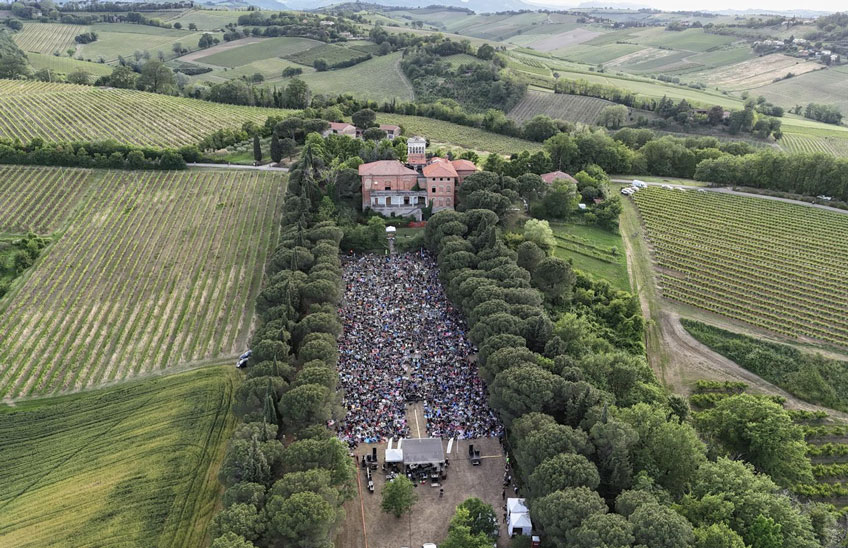
Guided by the words that in Genesis mark the succession of the days of Creation, the Festival reflects on the effects of climate change on our planet – adopting new eco-sustainable practices for live performance with the Romagna in fiore events in the places affected by the flood of 2023 – but also on the value of creativity as a resource for inclusive and multicultural communities. The reflection on the relationship between man and planet continues in the Qatsi Trilogy by Godfrey Reggio and Philip Glass and with Anohni and the Johnsons. Riccardo Muti is on the podium of the Wiener Philharmoniker for the opening concert, while he reaches Lampedusa with his Cherubini for The Roads of Friendship in the concert that closes the 35th edition. First time in Ravenna for Simon Rattle and Kirill Petrenko. In November, the Trilogy transports the audience to the Baroque 17th century, with two new productions by Pier Luigi Pizzi and Ottavio Dantone, at the head of Accademia Bizantina, and a recital by Jakub Józef Orliński.
The Invisible Cities
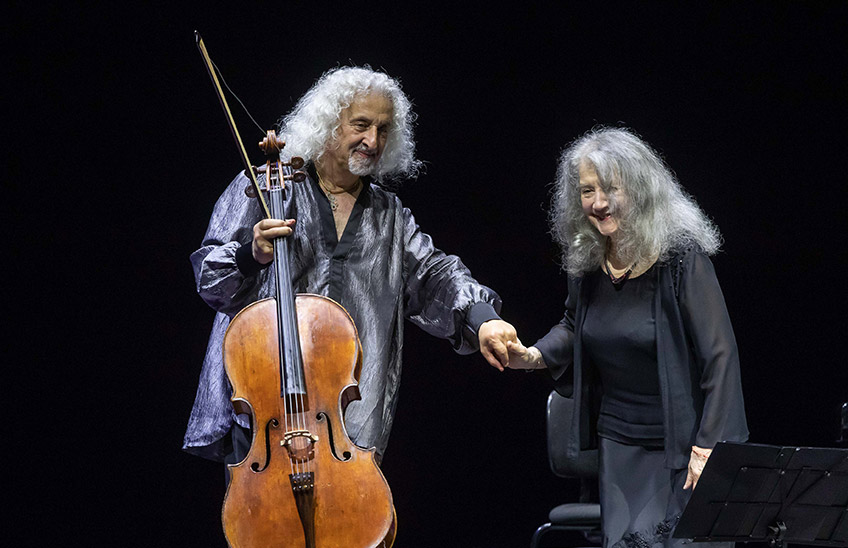
If Italo Calvino’s Invisible Cities are depicted as experiences, memories and desires rather than places, the centenary of the writer’s birth offers Ravenna Festival a happy pretext to reflect on the dual nature of the city, emblem of the community and its crisis, and its ‘invisible’ dimension as a crossroads of cultures, ideas and narratives. Titles that explore the terrible face of civilisation are contrasted with a celebration of dialogue between cultures and music worlds, and a double opening, featuring respectively Laurie Anderson and Martha Argerich, flanked by Mischa Maisky, opens a constellation of extraordinary soloists, from Anne-Sophie Mutter to Leonidas Kavakos and Beatrice Rana; the latter plays Rachmaninov for an evening with ballet stars (the dance programme also includes the Italian premiere of WE, the EYES by Emio Greco and Pieter C. Scholten). In December, Riccardo Muti – already on the podium of his Cherubini Orchestra for The Roads of Friendship in Jerash and Pompei – conducts an opera triptych with Norma and Nabucco in semi-staged form and a Verdi gala.
Between Flesh and Heaven
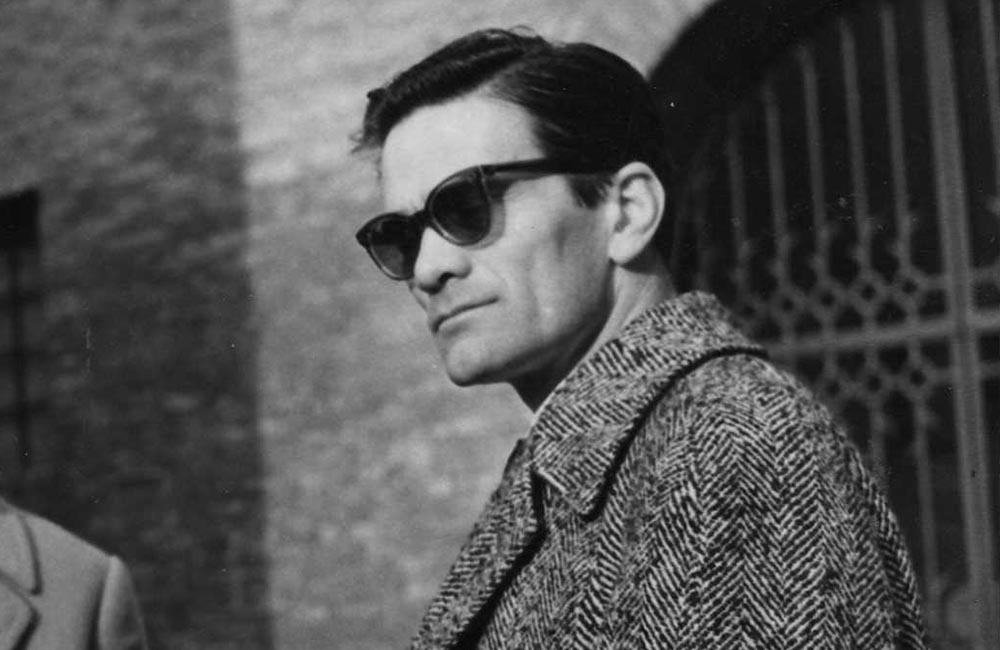
One hundred years after the birth of Pier Paolo Pasolini, the Ravenna Festival’s travels “Between Flesh and Heaven”, starting from Azio Corghi’s composition by the same name for the opening concert with Daniel Harding and the Mahler Chamber Orchestra. The words Pasolini used to describe his momentous encounter with Bach’s Violin Sonatas draw a not only musical thread that involves such artists as Giuseppe Gibboni, Accademia Bizantina, Elio Germano. The opposition of human and divine expressed by the title also offers a chance to explore the many facets of the sacred, through the homage to Franco Battiato as well as the events under the mosaic vaults of the Byzantine basilicas – but also the Friendship concerts in the shrines of Lourdes and Loreto, where Riccardo Muti leads Italian and Ukrainian artists; a spontaneous invocation to the Mother, image of all mothers. Because, as Pasolini wrote in Supplication to My Mother: “You are the only one in the world who knows, of my heart, what it has always been, before any other love”. On the other hand, the Autumn Trilogy celebrates secular love with Mozart and Da Ponte’s masterpieces in the productions from the royal palaces of Drottningholm and Versailles.
Continua a leggere
Dedicated to Dante
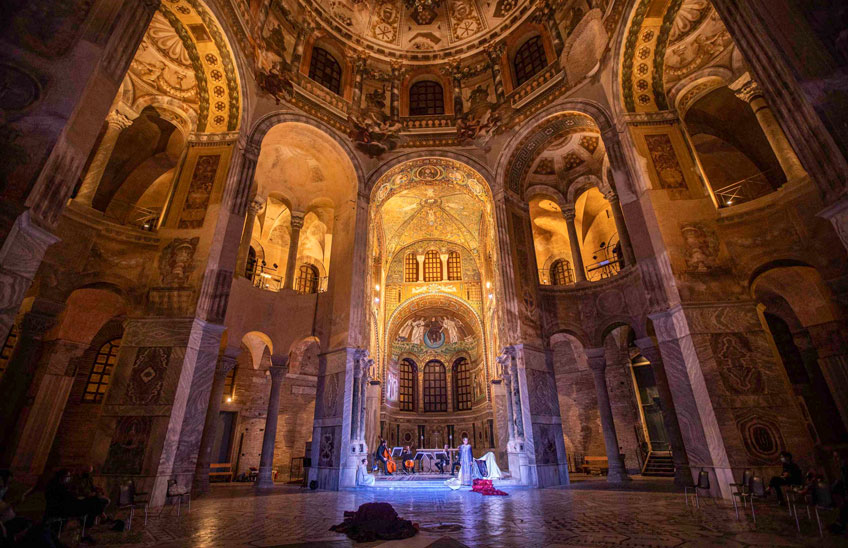
A dedication of love draws inspiration from the 7th centenary of Dante’s death for two months of events, planets and satellites that revolve around the central sun of the Poet and his masterpiece, but also follow other and more eccentric orbits. After the premiere with the Wiener, Riccardo Muti travels along The Roads of Friendship with his Cherubini and reaches Yerevan for Tigran Mansurian’s Purgatorio, part of a triptych of commissions that is completed by Giovanni Sollima’s Inferno and Valentin Silvestrov’s Paradiso. But this edition’s treasure trove of premieres also includes Mauro Montalbetti’s chamber opera Teodora and a restaging of L’heure exquise, co-produced with the Royal Ballet, with which Alessandra Ferri and Carsten Jung pay tribute to Béjart and Carla Fracci. The Autumn Trilogy follows the fil rouge of the Poet with three other new productions that explore the languages of dance, music, and words: Sergei Polunin dances his way through the realms of the afterlife, Goethe and Schumann meet for Faust’s dantesque journey in the imaginative staging directed by Luca Micheletti, while Elio Germano and Teho Teardo are entrusted with the luminous verses of the last canto of Paradiso.
Read more
32nd edition
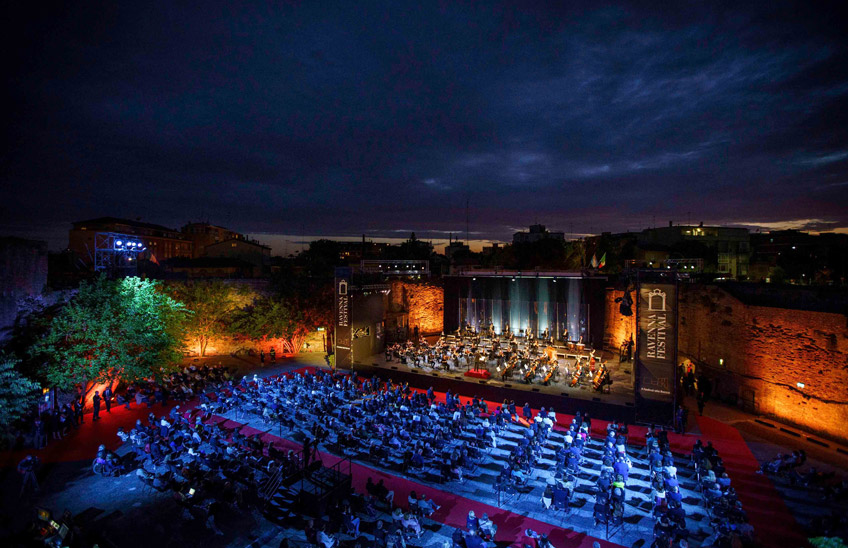
After the long deafening silence dictated by the restrictions aimed to control the Covid-19 pandemic, music in Italy restarts from Ravenna: in the Rocca Brancaleone, the Luigi Cherubini Youth Orchestra and soprano Rosa Feola join Riccardo Muti for the first concert with an audience, crowned by the solemn and grandiose “Jupiter” Symphony which lifted Mozart above the troubles of one of his life’s most dramatic times. The 31st edition, reimagined for an unprecedented situation, is also the first to reach tens of thousand spectators around the world. And while Muti and the Cherubini Orchestra also remember the suffering of the Syrian people with a concert in Paestum, sister-site of ancient Palmyra, Ravenna hosts the Budapest Festival Orchestra led by Iván Fischer, the Mariinsky Orchestra with Valery Gergiev, soloists Beatrice Rana and Mario Brunello for the étoiles of Duets and Solos, the single dance event this year. Faced with the second wave of infections, which again stops the events with an audience, in autumn Muti and the Cherubini perform in the Alighieri Theatre for two streamed concerts promoted around the world thanks to the partnership with the websites of El País, Rossiyskaya Gazeta, and Spring Festival in Tokyo.
Read more
On the High and Open Sea
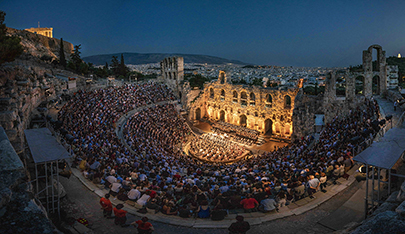
Sailing “on the high and open sea” the 30th edition – which opened under the sign of the greatest interpretation tradition with the meeting between Maurizio Pollini and Riccardo Muti – resumes the never truly dismissed vocation for travelling, beyond any boundary or diversity, and reaches the very foundation of our civilisation and mindset. In the heart of the ancient acropolis of Athens, Beethoven’s Symphony no. 9 is heard as a true hymn to brotherhood between peoples. Whilst the unrivalled voices of the Tallis Scholars are entrusted with the evocative journey through the Liturgy of the Hours, the relentless rhythm of the 100 percussions lets us glimpse the original source of music, but also its infinite variations: on the one side, Stewart Copeland’s surprising flexibility in a symphonic performance; on the other, Nick Mason’s timeless energy. The touching lyricism of Dante’s Purgatorio turns into a vivid play that calls for the whole city’s support, and three extraordinary women tower above the opera trilogy: Norma, Aida, and Carmen.
We Have a Dream
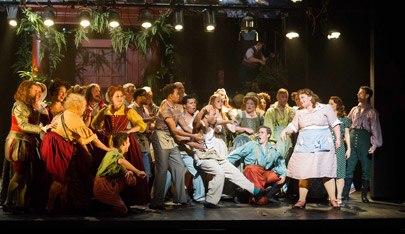
Recalling, half a century after Martin Luther King’s assassination, the title of his famous speech – made on the 28th of August, 1963, at the Lincoln Memorial in Washington and which has become a symbol of the fight against racism, and a hymn to freedom and equality all around the world – means to continue exploring key-events and icons of the 20th century, in the attempt of soothing the dismay and the anxieties undermining our age. Thus one enters the “veins of America”, keeping in mind to the huge contribution of the States to the culture of the 20th century: the biting roar of the 100 electric guitars, but also Cole Porter’s sophisticated musical Kiss Me, Kate. Without ever losing sight of “our” and ever-surprising Verdi heritage: Macbeth for the 50th anniversary of Riccardo Muti’s first time on the podium of the Maggio Fiorentino, but also the new Autumn Trilogy: Nabucco, Rigoletto, Otello.
The Noise of Time
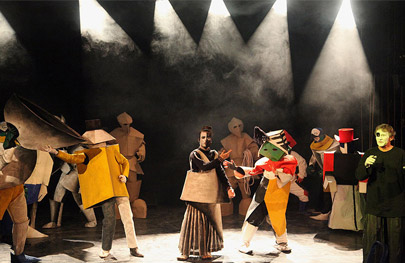
Paying a tribute to the October Revolution, a century later, means delving into its extraordinary energies, which expressed a deep yearning for Modernity, as well as into the searing disappointments and horrors that followed. It means to collect what remains beyond “the noise of time” – a title shared by Julian Barnes’s novel dedicated to Shostakovich and Osip Mandelstam’s prose. Between musical and artistic revolutions, the explosive vitality of Dante has been amplified in Inferno, with the open call to the citizens curated by Teatro delle Albe; while the new productions of the Autumn Trilogy have reached “the verge of the 20th century”, shedding new light on the Italian Realism: Cavalleria rusticana, Pagliacci, and Tosca. A dream comes true: the Roads of Friendship lead to Tehran, again with Riccardo Muti, again under the sign of the infallible common language of music
Ho camminato sulla lunga strada per la libertà
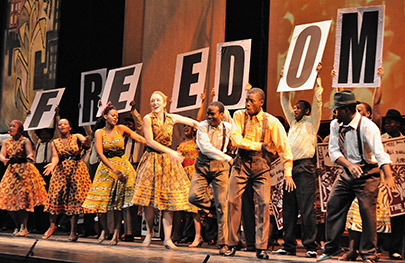
Nelson Mandela is at the heart of the route leading to the conquest of freedom, a precious and fundamental right. Hence “Mandela Trilogy” by Cape Town Opera, bringing the South African music tradition on stage. But the longing for freedom strongly transpires from the overwhelming passion of the 100 Cellos as well: led by Giovanni Sollima, they invade the city, drawing the audience to myriad concerts and performances. And, inevitably, to the daily appointments dedicated to “Young artists for Dante”, a few steps away from the Poet’s Tomb, and to the “Vespers at San Vitale”. Then, from the most active Hungarian theatres, a Danubian trilogy pays homage to the operetta: the freedom of lightness.
L’Amor che move il sole e l’altre stelle

A truly Dantesque “journey” winded along new creations, entrusted to composers like Adriano Guarnieri, with the video opera L’amor che move il sole e l’altre stelle, and Nicola Piovani with La vita nuova, sung on a recital by Elio Germano, soprano and small orchestra. But the musical theatre was protagonist with the great Italian opera tradition as well: it was to Verdi’s last masterpiece, Falstaff, that Riccardo Muti dedicated his first Italian Opera Academy.
1914: l’anno che ha cambiato il mondo
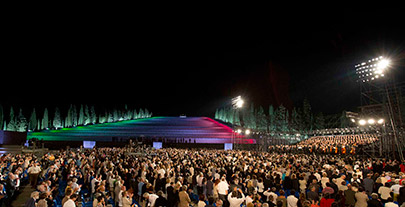
The L’elisir d’amore and La Bohème were staged not in a theatre but…among the tables of a restaurant, in the irreverent and revolutionary interpretation of the young British company OperaUpClose.
Many events were held to celebrate the hundredth anniversary of World War I, culminating in the concert held at the foot of the Redipuglia memorial monument, a symbol of the pain and memory. The musicians of the nations that suffered the most were led by Riccardo Muti’s baton.
Alchimie popolari “Una balera ai giardini”
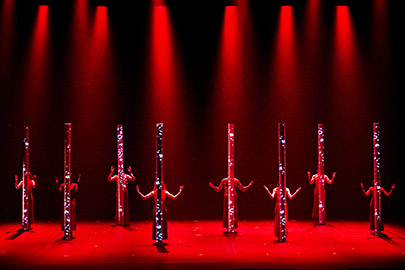
The acrobatic illusionism of Momix was performed with the world premiere of Alchemy. Then Romagna’s folk dances held the stage, with those waltzes, polkas, and mazurcas born in the farmyards of our countryside. The music could be heard everywhere, from the “balera” in the park in a whirlwind of a “polka day”, then passing over to Strauss’s noble Viennese dances, but also to Trovesi and Coscia’s jazz and the estranging sound of Simone Zanchini’s accordion, coming together at last for a festive tribute to Secondo Casadei.
The collection of musicians was enhanced by the performance of one of the greatest cellists of our times: Yo-Yo Ma.
Nobilissima Visione
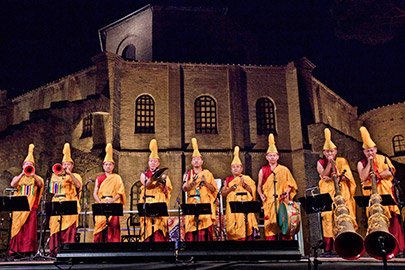
Grand opening with the Chicago Symphony Orchestra, on the podium of this extraordinary American group their musical director: Riccardo Muti. But, commemorating Romualdo of Ravenna, the festival’s theme covered the most remote spiritual paths of monasticism, and for an entire week the city was “invaded” by a small community of Tibetan monks from the ancient monastery of Drepung Loseling, and filled with the suggestive sounds of the mandala ritual. And the Roads of Friendship turned into a touching “Brotherhood Concert”, whereby different religious expressions came together.
The first of the Autumn Trilogy was reserved for Verdi: on stage, evening after everning, Traviata, Trovatore and Rigoletto, directed by Cristina Muti.
Fabula in Festival
Once upon a time… fairy tales took shape and came to life in the exciting and grim Cinderella by Matthew Bourne, and then in the explosive and joyful Impempe Yomlingo, Mozart’s Magic Flute turned into a musical and imbued with the rhythmic physicality of an orchestra of African marimbas. The Roads of Friendship arrived in Africa, at the Ururu Park of Nairobi.
Meanwhile Kent Nagano, Zubin Mehta and Claudio Abbado returned to the podium.
Ex tenebris ad lucem
Tenebrae, video-scenic cantata for recorded voices, ensemble, and live electronics, marked a new commission for composer Adriano Guarnieri (the first had been in 2007 with Pietra di diaspro) directed by Cristina Muti: bold experimentation of the visual and auditory space. But the visionary streak emerged also in Demons, Dostoyevsky’s masterpiece staged by Peter Stein: an unforgettable eleven-hour show.
The first “trekking concert” was created as well, a pathway among pinetrees and glades, archaeology and nature filled with songs, music, and dance.
…lâ ilahâ illâ… Quando ti sento arrivare il mio cuore danza, le mie braccia si aprono
Dance and theatre became prayer and ritual in the name of the Sufi mystic poet in Robert Wilson’s new piece, Rumi. In The Blink of the Eye, and through the absolute mastery of the body of Buddhist monks from the Shaolin Temple, guided in Sutra by choreographer Sidi Larbi Cherkaoui. And with the Basilica of San Vitale as a background, different religions intertwined in the charm of Voices in prayer, sounds and songs mixed in with thoughts and words by Massimo Cacciari. An exceptional duo for a grand finale: the prophet of funk, Herbie Hancock, and the most prodigious piano talent of the new generation, Lang Lang.
Erranti, erotiche, eretiche
Wandering, erotic, heretical… the female figure is evoked in all artistic expressions: from the most beloved operatic repertoire, Traviata (directed by Cristina Muti Mazzavillani), to the most superb étoiles of our time, Sylvie Guillaum and Svetlana Zacharova; from “portraits of women” including those outlined by Elena Bucci (the insane hunger of knowing by Juana de la Cruz), and by Ermanna Montanari (the proud Rosvita), to the imaginative encounter between Norma and Medea.
One of the most performed musicals in the world, Cats, thrilled the entire audience at the Palafiera of Forlì.
La pietra di diaspro “quando il cielo si squarcerà'”
The collaboration with the Salzburg Whitsun Festival was launched, a five-year project to rediscover the “Neapolitan School”. Under the direction of Muti masterpieces which had been forgotten for centuries were once again heard in the beautiful library of the conservatory in San Pietro a Majella, starting with Il ritorno di Don Calandrino (The Return of Don Calandrino) by Domenico Cimarosa.
And for the first time choreographer Matthew Bourne, with Swan Lake, chose Ravenna as the exclusive stage for his exciting productions.
Mozart? Mozart!
The edition dedicated to Mozart opened with one of the world’s most prestigious orchestras, the New York Philharmonic: two concerts, on the podium Lorin Maazel and Riccardo Muti. And among the “soloists” who took part in this edition there was the most acute and “intellectual” of pianists, Alfred Brendel, with the pure energetic talent of dancer Roberto Bolle. But, as usual, the “classical” dimension is not enough to describe the Festival: Eugenio Barba, transcultural pioneer, examined the theatre archetypes of all time – Don Giovanni and Hamlet.
Il deserto cresce…viaggio tra simbolismo e utopia
The voice of the muezzin echoed among the stones of the majestic Roman amphitheatre of El Djem, Tunisia, and Riccardo Muti lowered his baton, letting the religious call die down before returning to direct the Mephistopheles: “moments like this – he would later state – transcend different religions and cultures”, and underline the true meaning of the Roads to Friendship.
For the first time the “resident” orchestra, the Luigi Cherubini Youth Orchestra, perfomed at the Festival.
Illuminazioni sulla via di Damasco
Philip Glass, together with musicians from five continents, took inspiration from the stars of Orion, the constellation visible all year round from every part of the planet. And the Festival’s vocation of embracing different cultures and artistic forms took shape in La Galigo by Robert Wilson: the ancient Indonesian poem tells the story of the creation of the earth and the divine mystery was mirrored by the magic of colours and hieratic gesture of sixty extraordinary performers.
Ravenna visionaria “pellegrina e straniera”
A truly “Saison Russe” was on stage: the innovation of the Russian theatre, Helikon, and of its founder Dmitry Bertman invaded the Alighieri, with four works – from Tchaikovsky’s magnificent Queen of Spades to the sensual Lady Macbeth in the Mtsensk District of Šostakovič, from the funny eclecticism of Stravinskiy’s Mavra to the timbric virtuosity of Rimsky-Korsakov’s Kashchey the Deathless. And Russian is also the Festival’s dancing heart with the Kirov Ballet of the Mariinsky Theatre in St. Petersburg.
New York: 11 settembre
In New York’s wounded heart, on the edge of Ground Zero, where the blind terror struck every human certainty, in an absolute and unnatural silence, the notes of Verdi’s Va ‘pensiero resonated: Riccardo Muti led the Chorus of La Scala, the Musicians of Europe United, professors of leading European orchestras, and many members of the New York Philharmonic.
The Roads of Friendships arrived in the States as well, but one of the most emblematic American voices arrived in Ravenna, Bob Dylan.
Dalla via dell’ambra alla via della seta… in compagnia del grande bardo
The infinite expressive resources of opera were staged with the transgressive interpretation by Eimuntas Nekrošius (Otello) and with the virtual technology of Cristina Mazzavillani Muti’s first directorial experimentations (Capulets and Montagues). Pierre Boulez was back as well, while James Levine and Jeffrey Tate took the stage in Ravenna for the first time.
Cantastorie, gitani e trovatori
The new millennium Festival opened with a huge party: bright lights and amazing fireworks lit up the city, sounds and traditions of Romagna intertwined with southern ones, far into the night. This paved the way to a multi-faced programme: from Paisiello’s masterpiece, Nina o sia la pazza per amore, with Muti conducting on the podium of the La Scala complex, to Lou Reed’s memorable concert.
I pellegrinaggi della Fede anno III Verso Gerusalemme
With Pagliacci, Riccardo Muti completed the “verismo” diptych that he had begun a couple of years before with Cavalleria Rusticana. The same extraordinary creative team set the stage with Liliana Cavani as director, Oscar award-winning Gabriella Pescucci, and Dante Ferretti for costumes and scenery. But the Festival also moved toward renewed spirituality, along an unprecedented “via dei canti” (song pathways), from the perfection of the Hilliard Ensemble to the mysterious sounds of the baganna, the Ethiopian harp…searching for the “genius vocis”.
I pellegrinaggi della Fede, anno II Donna Mater, voci erranti del mondo
With Pagliacci, Riccardo Muti completed the “verismo” diptych that he had begun a couple of years before with Cavalleria Rusticana. The same extraordinary creative team set the stage with Liliana Cavani as director, Oscar award-winning Gabriella Pescucci, and Dante Ferretti for costumes and scenery. But the Festival also moved toward renewed spirituality, along an unprecedented “via dei canti” (song pathways), from the perfection of the Hilliard Ensemble to the mysterious sounds of the baganna, the Ethiopian harp…searching for the “genius vocis”.
“La via dei Romei” I Pellegrinaggi della Fede
At night, on a military plane, Riccardo Muti and the Orchestra of La Scala flew over the Adriatic, crossing over to Sarajevo, the Bosnian city wounded by the war, scattered with smouldering rubble and debris, calling for help and asking to be listened to. Thus Le Vie dell’Amicizia (The Roads to Friendship) were created, “bridges of brotherhood” casted every year to unite peoples and cultures through the power of music. That strength that emanated from the unique and unmistakable gesture of Carlos Kleiber, in one of his rare and precious concerts.
Ravenna mediterranea tra Oriente e Occidente (anno II)
For the first time the Wiener Philharmoniker took their place in the orchestra pit, outside of their own theatre. At the Alighieri they were led by Riccardo Muti for Così fan tutte under the very Neapolitan direction of Roberto de Simone. It was the first stage of the Mozart-Da Ponte trilogy, with Don Giovanni and Nozze di Figaro, that Muti and the Viennese would complete a few years later. But the Festival knew no genre boundaries since Keith Jarrett’s great jazz music rocked the festival.
Ravenna mediterranea tra Oriente e Occidente
Ravenna’s Mediterranean calling was rediscovered, a crossroads of cultures and ancient civilizations, suspended “between East and West”, from the incredible voice of Sister Marie Keyrouz to the flamenco of Cristina Hoyos. But evocative oriental echoes were heard with the concerts of the most prestigious performers as well: Misha Maisky, Martha Argerich, Mstislav Rostropovich, and Valery Gergiev.
Bellini e Wagner (anno secondo)
The collection of great conductors was enriched with new names: Giuseppe Sinopoli, Wolfgang Sawallisch, Seiji Ozawa, Myung-Whun Chung … and of course Riccardo Muti, the “local” conductor, leading a new production of Norma, and shining over the ancient mosaics of Sant’Apollinare in Classe with the expressive, powerful notes of Verdi’s Requiem.
Bellini e Wagner
The most prestigious of German orchestras, the Berlin Philharmonic conducted by Claudio Abbado, arrived in Ravenna for the prologue, while for the finale the unforgettable Italian voice of Luciano Pavarotti rose above the waters of the city’s harbour: both along the common thread connecting “Bellini and Wagner”. A memorable show was the Dantesque poetic workshop by Federico Tiezzi with Sandro Lombardi (I Magazzini) performing Paradiso (or Heaven), the dramaturgy by Giovanni Giudici, followed in the subsequent years by Purgatorio (or Purgatory) and Inferno (or Hell), by Mario Luzi and Edoardo Sanguineti respectively.
Intorno a Rossini
Everything revolved “around Rossini”: the kaleidoscopic musical universe of Rossini was transfused in the hypnotic and compelling choreography of Micha van Hoecke in Adieu à l’Italie. But also in the piano recitals by foremost names in Italian piano music such as Aldo Ciccolini and Maurizio Pollini.
Cherubini e la scuola francese
“Cherubini e la scuola francese” (Cherubini and the French School): Luca Ronconi’s direction and Riccardo Muti’s baton, with the Orchestra and Chorus of La Scala, brought on stage Lodoïska, the musical revolution of one of the greatest European composers. And for the first time on the austere backdrop of the Basilica of St. Francis “High Mass” was played, conducted yet again by Muti.
Salieri e la scuola di Vienna
The Ravenna Festival was created, in the name of great music and Dante. Riccardo Muti inaugurated the very first edition, then Pierre Boulez, Carlo Maria Giulini, Lorin Maazel took the stage, while Dante readings were carried out by Paolo Poli and Enrico Maria Salerno. Roman Vlad set the mood for the artistic stance.